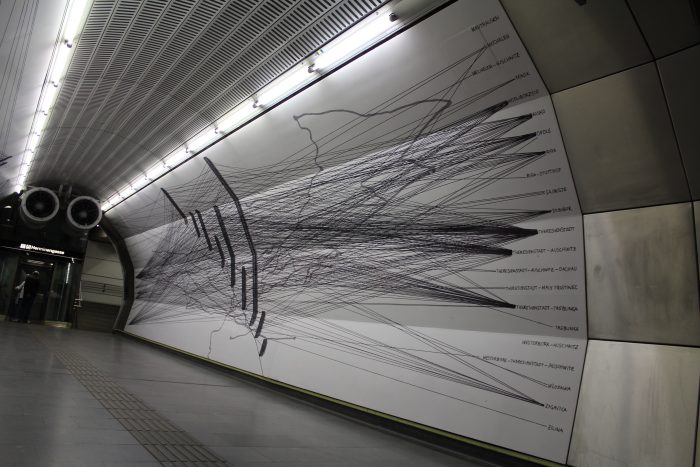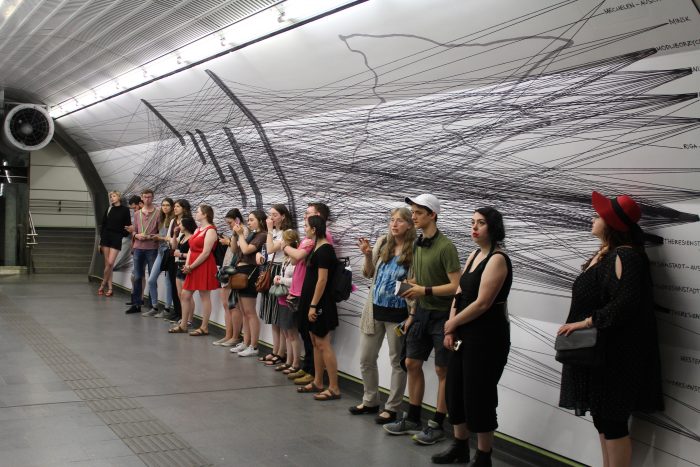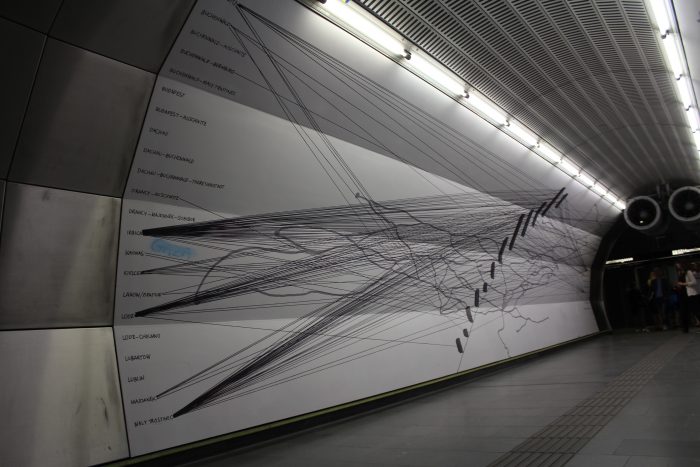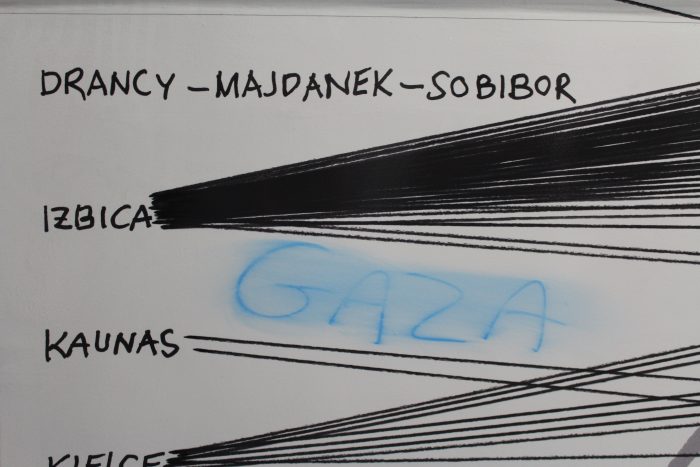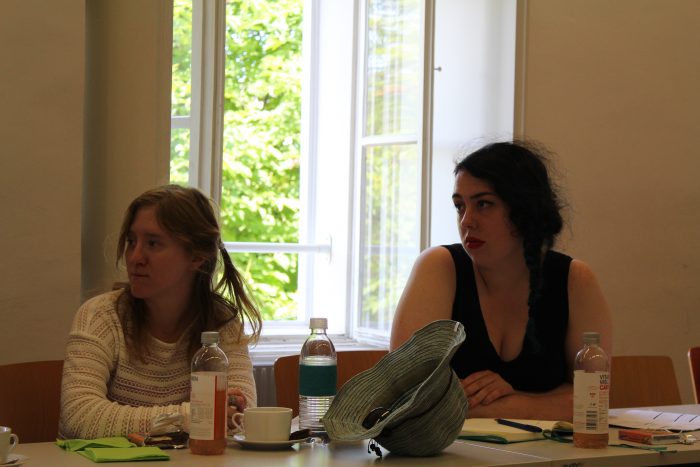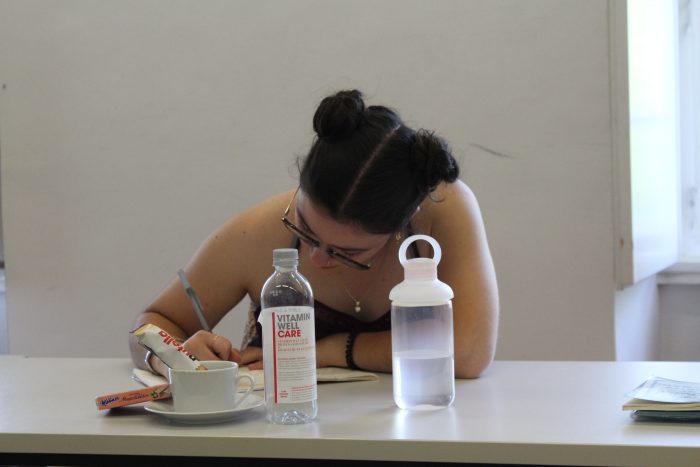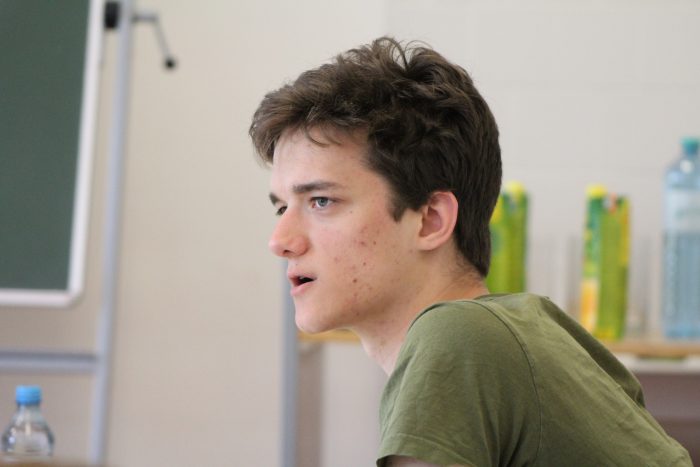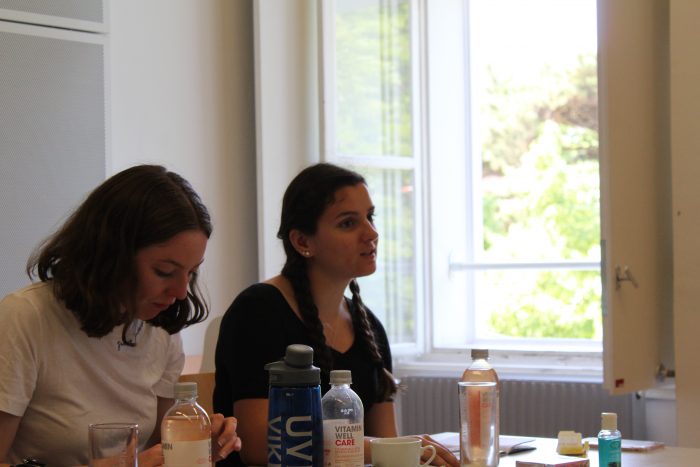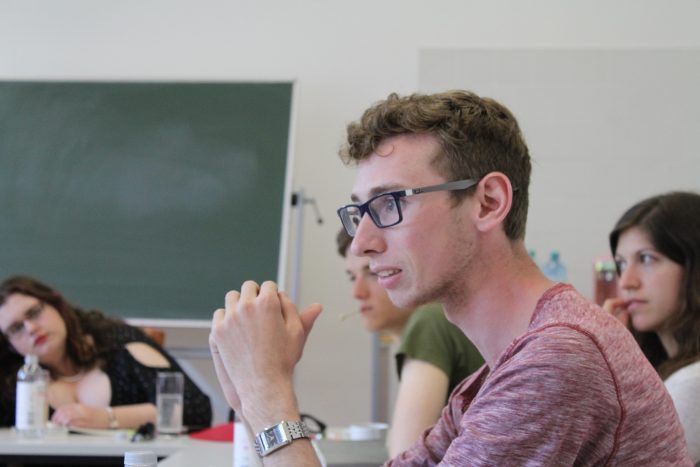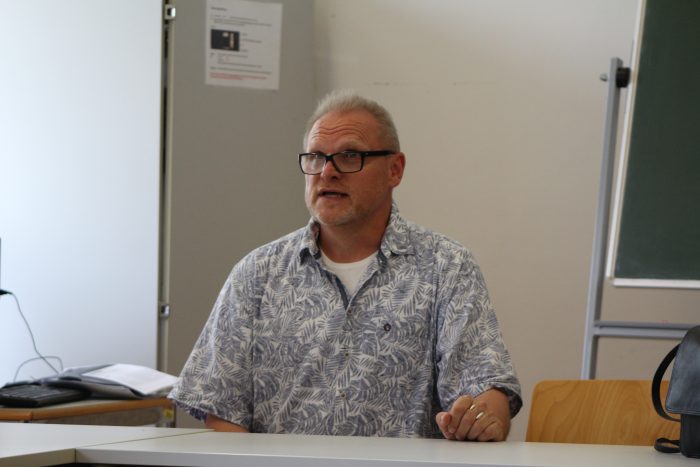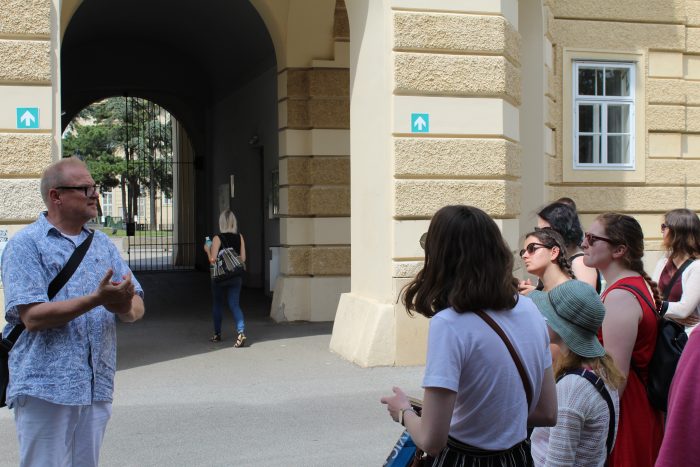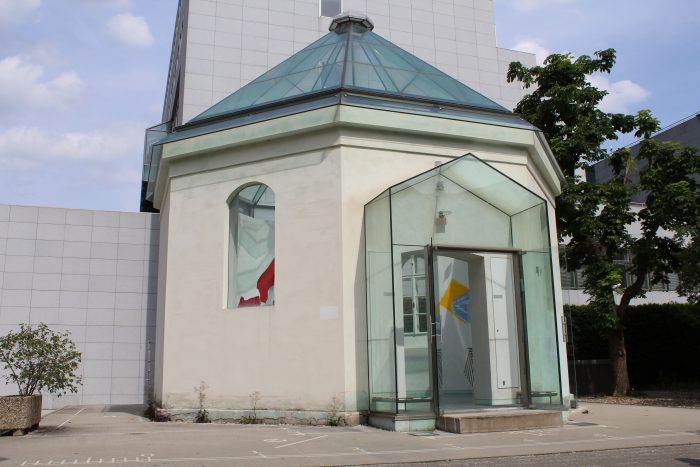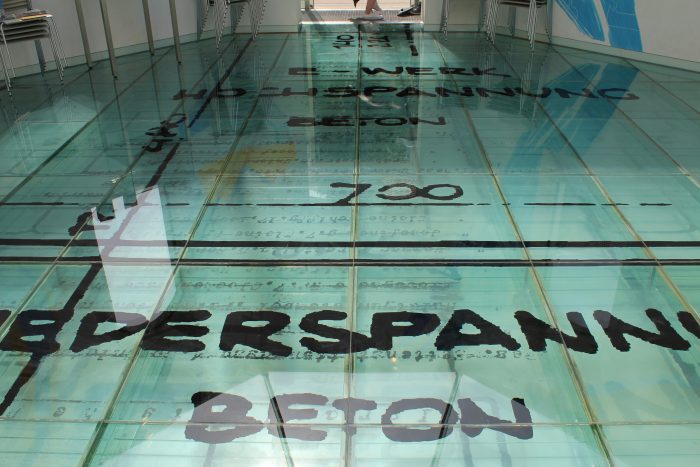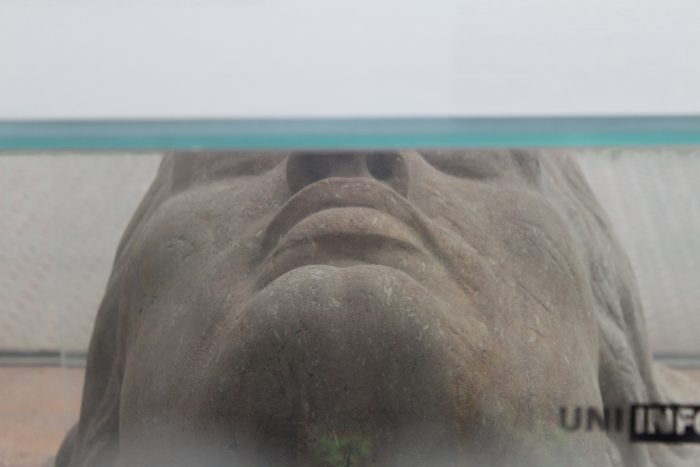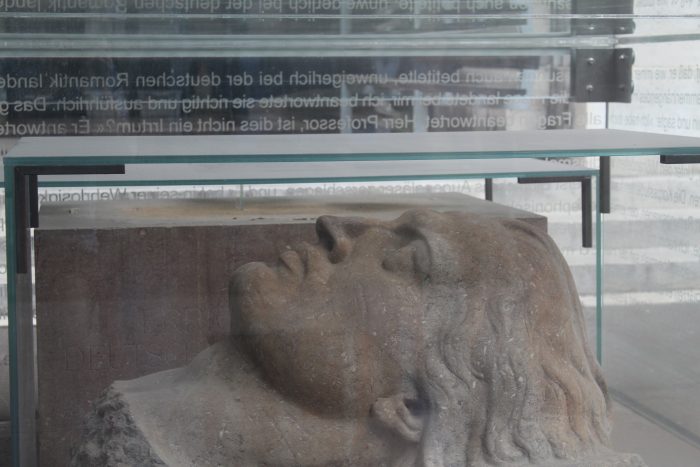I-Witness Holocaust Field School in Austria
 The I-Witness Holocaust field school (GMST 489) explores the ways in which the Holocaust is memorialized in Central Europe. Learn more on the field school blog.
The I-Witness Holocaust field school (GMST 489) explores the ways in which the Holocaust is memorialized in Central Europe. Learn more on the field school blog.
Guest post by Bryant Linton
Today (May 22) began with a trip through the Viennese metro. Our rail car shot along its concrete tubes with our group of 19 (+1 fantastic guest) all packed together among the Viennese.
At our station we turned corners in the cavernous halls of Vienna’s city transports. All the while busy natives shuffled by, not afraid to give a rough elbow with their quick “entschuldigung” when running for their trains. Us less rushed foreigners slowly made our way through the station, finding ourselves in the Herminengasse Holocaust mapping project.
The walls of the tunnel are etched with lines each representing the life of one of 800 deported Jews. Such lines are overlaid on a beige rail map. In the center are large charcoal-colored posts, representing the various buildings the Jews were deported from. Finally, on the walls are a list of names. Many are obscure Slavic-sounding or vaguely German words that I couldn’t recognize Izbica, Drancy, Kaunas, but among them are the more recognizable. Dachau, Buchenwald, Auschwitz. Each name is an endpoint of murder for the Jewish people. Each line of each represented Jewish life ends at one of these names.
The monument was complicated. It holds much meaning in a succinct and artful form. The buildings and the lines are to me reminiscent of disorder, the emotion of constrainment, and of course barbed wire fences. Some problematic points of this memorial are “why are some names chosen with no lines leading to them?” and “Does the average Austrian take time out of their commute to stop and remember in a busy tunnel?”
Another, final note on the memorial is that, under the hallowed Dachau, Buchenwald, Auschwitz, lies a graffitied blue “GAZA.” This vandalized equation of the Gaza strip to a death camp is a complicated one, with many more nuances than simple blue-spray paint or a blog post can faithfully delve into. But one thing is certain, this memorial is being understood. Even if it is only being understood by a politically motivated street artist.
From there we made our journey to the University of Vienna (Universität Wien) where we had a long and needed classroom discussion. After our long week in Berlin, it was required.
Ravensbrück concentration camp was our first topic. Although the resoundingly emotional and physical reactions to the KZ were negative, our experiences were not the same.
Some maintained distance and wanted to be alone. Some grew enraged at the site of the small German town of Fürstenburg, which was and is directly across the lake from the camp, less than a kilometer away. They indeed did know.
Personally, after turning the corner of the crematoria, my heart leaped in to my throat. We were all as prepared as we could be, we all signed up for this, but who could really know? Nothing really can prepare you for the site that’s sole purpose was erasure of a culture and an identity. Nothing can prepare you for a site where so many people burned.
The conversation continued into a division between praise and disillusionment with Holocaust remembrance and education. The stumbling stones were discussed, and the idea of “moving forward from the past, but not moving on, was brought up.” (Thanks Lindsay!) In the end, there was a discussion of the nature of Holocaust education in Germany and Austria, and if there was an end to the burden beared by the young of those nations for the crimes of their grandfathers.
Personally, I don’t know. The native Austrian we asked, and the native Germans I asked all seem desensitized to it. They are taught from birth that they are the sons and daughters of the perpetrators, they have a duty to remember. But if that duty is beaten into you daily you soon forget its reasons or purpose. Will there ever be a time when this burden must not be beared? Or should we do a greater job of sharing said burden, looking to our own crimes, Truth and Reconciliation and Japanese internment properties in Canada, Indian Wars and slavery in America?
Will there ever be a world that isn’t divided into perpetrators and victims? I hope so. We all hope so. Us children may not like to learn our hard truths, to swallow our societal medicine, but at the end of the day the children of the murderers are here and the children of the murdered are not.
Further we met with Austrian professor of memorialization, Herbert Posch.
He lectured on how the University of Vienna remembers its own bloodied past of ignorance. The university, through fascist periods post-1933 until 1945 expelled many political opponents from University, and all Jews during the Nazi era. Many University members sympathized with Nazi goals, and actively supported the persecution of Jewry. Only in the past ten years has the education capital of Austria begun to deal with its own very complicated past.
We traveled to many sites on campus, including places of remembrance to expelled students, including the world-renowned therapist Dr Martin A. Fischer, who after his expulsion in the 1940s, fled to Canada and pioneered the field of art therapy.
On the site of a former university synagogue, burned down by the Gestapo during a pogrom, is a new synagogue. Oddly designed, it is sweltering, with no ventilation in the summer, and no heating in the winter. At all times of the year it is most uncomfortable to enter. Nonetheless it is a fascinating building. On its giant glass floor is large lettering, illustrating the names of crossed out synagogues on the Gestapo’s list of those to burn in Vienna. The whole building gives an almost otherworldly, peaceful vibe, due to its modernist, revisionist architecture, laying on the stones of the old synagogue.
Finally, we saw a site of fascist and alt-right veneration, the head of the fascist statue of victory. On campus the statue became a target of defacement by democratic and leftist liberal students, as it held a prominent place in the university’s main hall, although it was a fascist monument, depicting a fascist narrative.
Even though the statue was eventually moved, it still continued to be used for propaganda by far-right groups and to be a target of vandalism for liberals. Now the head of the statue almost lies seemingly forgotten in a corner of a courtyard entombed and protected by glass, with a growing layer of dust.
The day was, like many other days hard on the knees and the soul. So many new things are thrown at us, but we continue our journey. But as we go by monument after monument sometimes it is difficult to remember that something did indeed happen here.
Only eighty or so years ago, bullets struck walls in Berlin, Vienna had emptied its streets amid the whine of bomb sirens, and a Swedish doctor in red cross garb walked through the gates of Ravensbrück to free women from hell.
The reality of those facts never truly leaves us, but unfortunately the world in which we live seems to have largely moved on.
(All Photo Credits to Pierus Bonnett)

